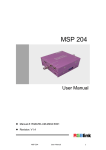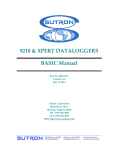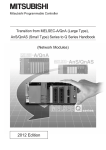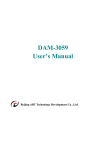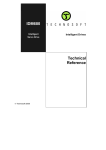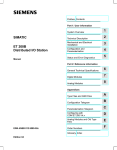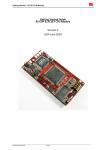Download Design and Implementation of a Documentation Tool for
Transcript
Design and Implementation of
a Documentation Tool
for Interactive Commandline Sessions
Andreas Dewald
Felix C. Freiling
Tim Weber
University of Mannheim
Technical Report TR-2010-005
December 30, 2010
Abstract
In digital investigations it is important to document the examination
of a computer system with as much detail as possible. Allthough never
designed for digital investigations, many experts use the software script
to record their whole terminal session while analyzing a target system. We
analyze script’s deficiencies and present the design and implementation
of forscript (forensic script), a software providing additional capabilities
and mechanisms for digital investigations.
1
1.1
Introduction
Motivation: Documentation of Terminal Sessions
During a digital investigation, many actions are still performed on the command
line. Especially in live response or during complicated manual operations it is
useful that the investigator keeps a detailed record of his actions while analyzing
a system. Such a log can help the investigator understand his motivations in
retrospect and can help prove to other experts that certain actions were or were
not performed during the investigation.
In principle, interactive command line sessions can be documented quite
easily by creating a piece of software that records everything typed on the
keyboard and everything sent to the screen. Many digital investigators still
use a program called script. The purpose of script is to record everything
printed to the users terminal into a file. According to its manual, “[i]t is useful
for students who need a hardcopy record of an interactive session as proof of an
assignment” [1]. But is it suitable for digital investigations?
1
1.2
Motivation: Deficiencies of script
The original script software consists of two programs: script and scriptreplay.
Both are now part of the util-linux-ng package [8] that is under active development. The most recent log entry within the source code of script and
scriptreplay, however, dates back to July 2000 when Andreas Buer “added
q-option”.
Technically, script creates a new pseudo terminal (PTY), which is a virtual,
software-based representation of a terminal line, and attach itself to the master
side of it, thereby being able to send and receive data to and from an application
connected to the slave side of the PTY. It launches a subprocess (also known as
child ), which launches the actual client application as its own subchild and then
records the client applications output stream. The parent process forwards the
users input to the client application. Recording terminates as soon as the child
process exits.
Script uses a very simple file format to save the typescript. Everything the
client application sends to the terminal, i.e., everything printed on screen, will
be written to the file, byte by byte, including control characters that are used
for various tasks like setting colors, positioning the cursor etc. Additionally, a
header "Script started on X\n" is written, where X is the human-readable
date and time when script was invoked. If script was invoked without the
-q flag, an additional footer "Script done on Y \n", where Y is the humanreadable date and time when script terminated, is written.
Apart from recording terminal in- and output, script can also record timing
data: Using the option -t, script will output timing data to stderr specifying
the chronological progress of the terminal session. Using this data, the utility
scriptreplay can display the recorded data in a video-like way. The timing
output format is very simple. It consists of tuples of delay and byte count
(space-separated), one per line, like in the following example:
0.725168
0.006549
0.040017
4.727988
0.047972
56
126
1
1
1
Each line can be read like x seconds after the previous output, n more bytes
were sent to the terminal. If there was no previous output (because it is the
first line of timing information), the delay specifies the time between script
invocation and the first chunk of output.
The two file formats produced by script show several shortcomings with
regard to their use in digital investigations:
• Input coming from the users keyboard is not logged at all. A common
example is the user entering a command in the shell but then pressing ^C
instead of return. The shell will move to the next line and display the
2
prompt again; there is no visible distinction whether the command was
run or not.1
• Metadata about the environment script runs in is not logged. This leads
to a high level of uncertainty when interpreting the resulting typescript,
because even important information like the character set and encoding
but also the terminal size and type is missing.
• Typescript and timing are separate files, but one logical entity. They
should reside in one file to protect the user from confusion and mistakes.
• Appending to a typescript file is possible, but ambigious, since the beginning of a new part is determined only by the string "Script started
on ". Also, appending to a typescript and recording timing information
are incompatible, because scriptreplay will only ignore the first header
line in a typescript file. Subsequent ones will disturb the timings byte
counter.
• In a sense, script is a typical Unix utility written in a single C file with
hardly any code documentation beyond the manual page. Therefore, it is
rather cumbersome to read and requires some effort to understand. We
believe that software used in digital investigations should strive for better
readability such that it is easier to quickly convice an expert that the code
actually does what it promised.
1.3
Forensic script: forscript
Overall, script has severe deficiencies when used in digital investigations. In
this paper, we report on the design and implementation of a successor tool
forscript (“forensic script”). The main advantages of this tool are:
• forscript has the same command line user interface as script, i.e., users
used to script can seamlessly switch to forscript.
• forscript defines a portable and extensible file format that contains all
user input, timing information and detailed information about the environment. The file format allows appending of files in a natural way.
• Following the paradigm of literate programming [4] and using the programming tool noweb [5], forscript comes with its own user manual and
documentation. In fact, this version of the paper contains the entire C
source code in a well-readable way, i.e., this document is the program and
vice versa.
1 With more recent versions of Linux and Bash, terminals which have the ECHOCTL bit set
(for example via stty) will show ^C at the end of an interrupted line, which fixes this problem
to some degree. Similar issues, like finding out whether the user entered or tab-completed
some text, still persist.
3
Literate programming [4] is a technique invented by Knuth when developing
the TEX typesetting system. Instead of writing more or less commented source
code, it propagates writing a continuous text with embedded code fragments.
The tool noweb [5] is used to reassemble these code fragments so that they can
be compiled into an executable program. Because of its advantages in creating
readable source code, we feel that there is much potential for the use of literate
programming in the development of software for digital investigations.
1.4
Roadmap
In Section 2, we elaborate the user interface of forscript, which basically is
that of script. In Section 3 we present the extensible file format of forscript.
We give a brief insight into the implementation of forscript in Section 4. The
program is evaluated in Section 5, giving an example transcript file. Finally,
Section 6 summarizes the work, gives a description of forscripts limitations
and describes possibilities of future work.
The appendix completes the code given in Section 4 to form a complete
literate program and can be consulted at the discretion of the reader. A chunk
and identifier index appear at the end of this document.
2
User Interface of forscript
Since Forscripts invocation syntax has been designed to be compatible to
script, most parameters result in the same behavior. We now give an overview
over the interface of forscript and highlight the differences to the interface of
script.
Forscript takes one optional argument, the file name of the output file (also
called transcript file) to which the terminal session is logged. If no file name was
supplied on the command line, the default name is transcript. This differs
from scripts default name typescript intentionally, because the file format
is different and can, for example, not be displayed directly using cat. If there
are any scripts or constructs that assume the default output file name to be
typescript, the chance that replacing script with forscript will break their
functionality anyway is quite high. If the file already exists and is a symbolic
or hard link, forscript refuses to overwrite the file, as long as the file name is
not explicitly provided.
There are several command-line switches that modify forscript’s behavior.
For example, using -a it is possible to append the output of forscript to a
transcript file. If the target transcript file already exists and is non-empty, it
has to start with a valid and supported file version header that will be explained
below.
Normally, forscript displays a message when it starts or quits and also
it records its startup and termination time in the typescript file. With the
parameter -q, all of these messages will not appear (quiet). This is similar to
the behavior of script, only that no startup message will be written to the
4
transcript file. This is because scriptreplay unconditionally discards the first
line in a typescript file and so writing the startup message ("Script started
on ...") cannot be disabled in script.
By default, forscript will launch the shell specified by the environment
variable $SHELL. If $SHELL it is not set, a default shell selected at compile time
(/bin/sh, see page 32) is used. The shell will be called with -i as its first
parameter, making it an interactive shell. However, if forscript is called with
the -c option followed by a command, it will launch the shell with -c and the
command instead of -i. The shell will then be non-interactive and only run the
specified command, then exit. Note that all POSIX-compatible shells have to
support the -i and -c parameters. This behavior is identical to that of script.
If the -f switch is used, forscript will call fflush() on the transcript
file after new data has been written to it, resulting in instant updates to the
typescript file, at the expense of performance. This behavior is identical to that
of script and is useful for letting another user watch the actions recorded by
forscript in real time.
The parameter -t was used in script to output timing information. This
parameter is accepted by forscript but ignored since forscript always records
timing information into the transcript file.
Finally, if forscript is called with -V or --version as only parameter, it
will print its version and exit. This behavior is identical to that of script.
If unsupported parameters are passed, forscript will print a short usage
summary to stderr and exit. While running, the client applications output will
be printed to stdout. Error messages will be printed to stderr.
3
Forscript File Format
This section explains the new file format as used by forscript. The file format
allows an efficient combination of output and metadata within a single file.
A forscript data file (called a transcript file) consists of the mostly unaltered output stream of the client application, but includes blocks of additional
data (called control chunks) at arbitrary positions. A control chunk is started by
a shift out byte (0x0e) and terminated by a shift in byte (0x0f). Each control
chunk is either an input chunk or a metadata chunk.
3.1
Input Chunks
Input chunks contain the data that is sent to the client applications input
stream, which is usually identical to the users keyboard input. They are of
arbitrary length and terminate at the shift in byte. If a literal shift out or shift
in byte needs to appear in an input chunks data, it is escaped by prepending a
data link escape byte (0x10). If a literal data link escape byte needs to appear in
an input chunks data, it has to be doubled (i.e., 0x10 0x10). For example, if the
user sends the byte sequence 0x4e 0x0f 0x00 0x61 0x74 0x10, the complete
5
binary value
0x01
0x02
0x03
0x12
0x13
0x16
type name
file version
begin of session
end of session
environment variables
locale settings
delay
size
1 byte
10 bytes
1 byte
arbitrary number of C strings
7 C strings
two 4-byte values
Table 1: forscript file format metadata chunk types.
input chunk written to the transcript file is 0x0e 0x4e 0x10 0x0f 0x00 0x61
0x74 0x10 0x10 0x0f.
3.2
Metadata Chunks
Metadata chunks, also called meta chunks, contain additional information about
the file or the applications status, for example environment variables, terminal
settings or time stamps. They contain an additional shift out byte at the beginning, followed by a byte that determines the type of metadata that follows.
The available types are listed in Table 1 and implemented in Appendix A.3.
Meta chunks can be of arbitrary length and terminate at the shift in byte.
The same escaping of shift out, shift in and data link escape that is used for
input chunks is also used for meta chunks. For example, the terminal size
meta type is introduced by its type byte 0x11, followed by width and heigth
of the terminal, represented as two unsigned big-endian 16-bit integers. The
information terminal size is 8016 characters would be written to the transcript
file as 0x0e 0x0e 0x11 0x00 0x50 0x00 0x10 0x10 0x0f. Note that the least
significant byte of the number 16 has to be written as 0x10 0x10 to prevent the
special meaning of 0x10 to escape the following 0x0f.
3.3
Properties of the File Format
This basic file format design has several advantages:
• New meta chunk types can be introduced while still allowing older tools
to read the file, because the escaping rules are simple and the parsing
application need not know a fixed length of each type.
• Since switching between input and output data occurs very often in a
usual terminal session, the format is designed to require very little storage
overhead for these operations.
• The format is very compact and easy to implement. Using a format like
XML would decrease performance and require sophisticated libraries on
the machine forscript is run on. However, for forensic usage it is best
to be able to use a small statically linked executable.
6
• Converting a forscript file to a script file is basically as easy as removing everything between shift out and shift in bytes (while respecting
escaping rules, of course).
4
Implementation Oveview
We give a brief insight into the code of forscript that is assembled within a
single C source file and written as a literate program [4] using the tool noweb [5].
The noweb tool automatically introduces cross-references between code chunks
so that readers can quickly find the corresponsing code. We only show the most
interesting code chunks here. The full details can be found in the appendix.
7a
hforscript.c 7ai≡
hdeclarations and definitions 15bi
hfunctions 15ci
hmain 7bi
4.1
The Main Program
Here is the main() function. We first determine the program’s name (as called
on the command line), then we process the command line options. Afterwards
we open the output file and a new pseudo terminal. The original script uses
one process to listen for input, one to listen for output and one to initialize
and execl() the command to be recorded. forscript in contrast uses only
the select() function to be notified of pending input and output and therefore
only needs two processes: itself and the subcommand. These two processes
are forked after registering the appropriate signal handlers. Since neither the
parent nor the child process should ever reach the end of main(), it returns
EXIT FAILURE.
7b
hmain 7bi≡
int main(int argc, char *argv[]) {
hset my name 24ci
hprocess command line options 25bi
hopen output file 26ci
hopen new pseudo terminal 28ei
hregister signal handlers 8ai
hfork subprocesses 8ci
return EXIT_FAILURE;
}
(7a)
Defines:
main, never used.
4.2
Registering Signal Handlers
To be notified of an exiting subprocess, a handler for the SIGCHLD signal needs
to be defined. This signal is usually sent by the operating system if any child
7
processs run status changes, i.e., it is stopped (SIGSTOP), continued (SIGCONT)
or it exits. script terminates if the child is stopped, but forscript does
not, because it uses the SA NOCLDSTOP flag to specify that it wishes not to be
notified about the child stopping or resuming. The function finish() handles
the childs termination. The second signal handler, resized(), handles window
size changes.
8a
hregister signal handlers 8ai≡
{ struct sigaction sa;
sigemptyset(&sa.sa_mask);
sa.sa_flags = SA_NOCLDSTOP;
sa.sa_handler = finish;
sigaction(SIGCHLD, &sa, NULL);
sa.sa_handler = resized;
sigaction(SIGWINCH, &sa, NULL);
}
(7b)
Uses finish 37b and resized 30a.
These functions and constants require signal.h.
8b
hincludes 8bi≡
#include <signal.h>
4.3
(15b) 18a .
Forking
When a progam calls the fork() function, the operating system basically clones
the program into a new process that is a subprocess of the caller. Both processes
continue to run at the next command after the fork() call, but the value fork()
returned will be different: The child will see a return value of 0, while the parent
will retrieve the process ID of the child. A negative value will be returned if the
fork did not succeed.
8c
hfork subprocesses 8ci≡
if ((CHILD = fork()) < 0) {
perror("fork");
die("fork failed", 0);
}
(7b) 9 .
Uses CHILD 8d and die 23b.
CHILD is used in several places when dealing with the subprocess, therefore
it is a global variable.
8d
hglobals 8di≡
int CHILD = 0;
(15b) 15a .
Defines:
CHILD, used in chunks 8c, 9, 23b, 35, and 37b.
8
After forking, the child launches (or, to be exact, becomes) the process that
should be logged within doshell, while the parent does the actual input/output
logging within doio.
9
hfork subprocesses 8ci+≡
if (CHILD == 0)
doshell();
else
doio();
(7b) / 8c
Uses CHILD 8d, doio 33c, and doshell 31c.
Further code can be found in the appendix.
5
Evaluation
In order to show you what the code you have just seen actually does, this section
contains instructions on how to compile it, and it features an example transcript
file analyzed in detail.
5.1
Compiling forscript
forscript is written conforming to the C99 and POSIX-1.2001 standards,
with portability in mind. It has been developed on a machine running Linux
2.6.32 [6], using glibc 2.10 and GCC 4.4.3 [2]. The following command line is
an example of how to compile forscript:
gcc -std=c99 -Wl,-lrt -g -o forscript -Wall \
-Wextra -pedantic -fstack-protector-all -pipe forscript.c
To generate forscript.c out of the noweb source code, the following command line can be used:
notangle -Rforscript.c forscript.nw > forscript.c
On the authors machine, forscript can be compiled without any compiler
warnings. It has also been successfully compiled on NetBSD.
Since Apple Mac OS X in its current version 10.6.2 lacks support for the realtime extension of POSIX, the clock gettime() function required by forscript
is not natively available. Therefore the code described in this document can in
its current state not be compiled on OS X. However, it should be possible
to create a function emulating clock gettime() and then port forscript to
OS X.
5.2
Example Transcript File
To demonstrate forscripts output, the following pages contain a commented
hex dump of a transcript file created on the authors machine. The dump has
been created using hexdump -C transcript. Since metadata chunks do not
9
necessarily start or end at a 16-byte border, the dump has been cut into distinct pieces, bytes not belonging to the current logical unit being replaced by
whitespace. The hex dump consists of several three-colum lines. The first two
columns contain 16 bytes of data represented in hexadecimal form, eight bytes
each. The third column represents these 16 bytes interpreted as ASCII characters, nonprintable characters are replaced with a single dot.
The transcript starts with a file version chunk, specifying that version 1 is
used:
0e 0e 01 01 0f
|.....
|
Then a start of session chunk follows.
0e 0e 02
4b 82 d0 f3 04 4d 8b e3
00 3c 0f
|
|.<.
...K....M..|
|
Its first eight bytes, (4b to e3) tell you that the time is 1266864371.072190947
seconds after the epoch, which is February 22, 2010, 18:46:11 UTC. The next
two bytes, 00 3c represent a timezone of 60 which translates to UTC+01:00.
After this chunk, the environment variables are listed. These are name=value
pairs, separated by null bytes. This information is important to interpret the
actual terminal data: For example, different control codes are used depending
on the TERM variables setting.
50
4e
2d
65
72
62
32
53
6d
37
48
2f
75
72
65
2e
3d
45
4c
57
50
45
6e
63
49
54
4b
6e
78
61
36
53
70
2f
3d
75
73
2f
2f
55
37
3d
3d
49
4c
52
69
72
44
5f
50
74
76
73
32
48
2f
61
2f
73
72
67
73
54
3b
2f
32
4e
41
4d
2f
69
0e
3d
49
62
3a
74
68
39
5f
73
67
68
72
2f
61
63
46
64
68
00
44
59
3d
62
70
0e
31
4e
79
31
00
00
38
41
73
65
6f
2f
62
6d
79
2d
65
6f
4c
4f
3d
72
61
74
12
36
46
65
36
53
57
34
55
68
6e
6d
6c
69
65
00
38
66
6d
4f
57
3a
78
63
00
53
33
4f
43
33
48
49
00
54
2d
74
65
6f
6e
73
4c
00
61
65
47
50
30
76
68
0f
53
30
3d
2f
31
45
4e
55
48
64
2e
2f
63
3a
00
41
43
75
2f
4e
41
2e
74
65
48
00
2f
53
3a
4c
44
53
5f
63
31
73
61
2f
50
4e
4f
6c
73
41
54
30
2d
6c
5f
47
74
2e
31
4c
4f
45
53
74
36
63
6c
62
57
47
4c
74
63
4d
48
00
78
6f
41
50
6d
67
00
3d
57
52
4f
77
30
79
2f
69
44
3d
4f
3b
79
45
3d
43
70
72
10
47
47
70
70
54
2f
49
3d
43
4b
37
2f
62
6e
3d
65
52
30
00
3d
37
4f
6d
2f
45
5f
2f
67
45
62
44
73
4b
42
00
62
69
3a
2f
6e
46
00
53
73
00
4c
00
66
4e
41
67
2d
52
69
3d
63
3d
31
50
69
6e
2f
68
5f
47
48
48
63
44
4f
5f
6f
54
47
70
61
4d
6e
32
79
2f
36
41
6e
3a
75
6f
55
42
4f
4c
79
49
52
3d
72
5f
45
67
67
3d
2f
37
00
74
30
54
3a
2f
73
6d
53
47
4d
56
00
53
54
75
73
|
...SSH_AGENT_|
|PID=1630.GPG_AGE|
|NT_INFO=/tmp/gpg|
|-KPbyeC/S.gpg-ag|
|ent:1631:1.TERM=|
|rxvt.SHELL=/bin/|
|bash.WINDOWID=27|
|262984.USER=scy.|
|SSH_AUTH_SOCK=/t|
|mp/ssh-dctwKB160|
|7/agent.1607.PAT|
|H=/home/scy/bin:|
|/usr/local/bin:/|
|usr/bin:/bin:/us|
|r/games.PWD=/hom|
|e/scy.LANG=en_US|
|.UTF-8.COLORFGBG|
|=7;default;0.HOM|
|E=/home/scy.SHLV|
|L=2.LOGNAME=scy.|
|WINDOWPATH=7.DIS|
|PLAY=:0.0.COLORT|
|ERM=rxvt-xpm._=u|
|ni/bachelor/fors|
|cript..
|
The next chunk contains the locale settings the C library uses for messages,
number and currency formatting and other things. Although the user may
choose different locales for either category, they are usually all the same. This
example makes no difference: The system is configured for US English and a
character encoding of UTF-8.
55
38
5f
55
38
54
00
55
54
00
46
65
53
46
65
2d
6e
2e
2d
6e
38
5f
55
38
5f
00
55
54
00
55
65
53
46
65
53
0e
6e
2e
2d
6e
2e
0e
5f
55
38
5f
55
13
55
54
00
55
54
65
53
46
65
53
46
6e
2e
2d
6e
2e
2d
5f
55
38
5f
55
38
55
54
00
55
54
00
53
46
65
53
46
0f
2e
2d
6e
2e
2d
|
...en_US.|
|UTF-8.en_US.UTF-|
|8.en_US.UTF-8.en|
|_US.UTF-8.en_US.|
|UTF-8.en_US.UTF-|
|8.en_US.UTF-8.. |
The terminal forscript is running in is 168 characters wide (00 a8) and
55 characters high (00 37), as the terminal size chunk shows:
0e
0e 11 00 a8 00 37 0f
|
|.....7.
.|
|
After all these metadata chunks, this is where actual terminal output starts.
Since the -q flag was not used, forscript writes a startup message both to
the terminal and the transcript, containing date and time and the file name.
The final two bytes 0d 0a represent the control codes carriage return and line
feed. Note that in contrast to the Unix convention of using just line feed (\n) to
designate new line in text files, a terminal (or at least the terminal the authors
machine is using) requires both bytes to be present.
20
32
36
65
0a
73
32
3a
20
74
20
31
69
61
46
31
73
72
65
20
20
74
62
50
74
65
20
4d
72
66
64
32
20
61
6f
20
30
43
6e
72
6f
31
45
73
73
6e
30
54
63
63
20
20
2c
72
72
4d
30
20
69
69
6f
37
66
70
70
6e
3a
69
74
74
20
34
6c
0d
|
forscript|
| started on Mon |
|22 Feb 2010 07:4|
|6:11 PM CET, fil|
|e is transcript.|
|.
|
Now the shell is started. It requires some time to read its configuration files
and initialize the environment, therefore forscript has to wait for it and starts
measuring the time until the next piece of data arrives. After the shell has
initialized, it prints out its prompt. On this machine, the prompt (scy@bijaz ~
master ? 0.11 19:46 $) is a rather complicated, colored one and therefore
contains lots of ISO 6429 control codes (also known as ANSI escape codes) to
define the visual appearance.
However, before the prompt is written to the data file, forscript writes a
delay meta chunk: It took 0.065087679 seconds before the prompt was printed.
0e 0e 16
3b 73 63 79
3b 33 32 6d
5b 31 3b 33
00
40
73
32
00
62
63
6d
00
69
79
62
00
6a
1b
69
03
61
5b
6a
e1
7a
30
61
28
3a
3b
7a
11
bf
7e
33
1b
0f
07
32
5b
1b
1b
6d
31
5d
5b
40
3b
30
31
1b
33
| .........(...]0|
|;scy@bijaz:~..[1|
|;32mscy.[0;32m@.|
|[1;32mbijaz.[1;3|
34
65
20
30
6d
6d
72
1b
3b
20
20
20
5b
33
7e
3f
30
33
20
20
3b
6d
1b
1b
33
1b
5b
5b
37
5b
30
31
6d
31
3b
3b
31
3b
33
33
39
33
36
30
3a
32
6d
6d
34
6d
6d
30
36
24
61
2e
20
1b
73
31
1b
5b
74
31
5b
30
|4m ~ .[0;36mmast|
|er ? .[1;30m0.11|
| .[0;37m19:46 .[|
|0;33m.[1;32m$.[0|
|m
|
Next, 1.291995750 seconds after the prompt has been printed, the user types
the letter e on the keyboard. The letter is enclosed by 0e and 0f in order to
mark it as input data.
0e 0e 16 00 00 00
01 11 67 80 66 0f 0e 65
0f
|m ........g.f..e|
|.
|
After the letter has been typed, the kernel will usually echo the character,
that is, put it into the terminals output stream to make it appear on screen. It
will take a small amount of time (in this case 0.0079911 seconds) until forscript
receives the character and write it to the transcript file, this time declaring it
as output.
0e 0e 16 00 00 00 00
00 79 ef 3c 0f 65
| ........y.<.e
|
The user now continues to type the characters echo -l, which will be echoed
as well.
16
16
00
00
c4
54
20
0e
16
00
00
b7
00
00
00
00
94
0f
0f
16
00
00
00
45
00
00
0a
79
0f
6f
0e
00
00
14
7a
0f
00
00
7d
db
0e
0e
0e
00
00
fb
01
00
00
bf
51
6f
0e
16
00
00
28
3d
05
00
1e
0f
0f
16
00
01
00
4d
0f
b9
79
0f
68
0e
00
00
2f
79
0f
6c
48
a5
0e
0e
0e
00
00
35
bb
0e
0e
10
09
68
0e
16
00
00
2a
20
6c
0e
10
0f
0f
16
00
02
00
bc
0f
0f
16
0f
63
0e
00
00
09
79
0f
2d
0e
00
0e
0e
0e
00
00
89
f2
0e
0e
0e
00
63
0e
16
00
00
aa
83
2d
0e
16
00
0f
16
00
00
00
a1
0f
0f
16
00
00
0e
0e
00
00
0b
79
0f
20
0e
00
00
2b
0e
0e
00
00
71
fc
0e
0e
0e
00
00
64
|
..|
|.......H....c...|
|......y...c.....|
|...}....h.......|
|..y.Q.h........q|
|....o.........y.|
|T.o.............|
| .........y... .|
|....../5*...-...|
|......y. .-.....|
|....(M..l.......|
|..z.=.l.......+d|
|.E.
|
Since typing the l was a mistake, the user presses the backspace key (ASCII
value 127) to remove the last character.
0e 7f 0f
|
...
|
After the usual delay, the shell will send two things to the terminal: First, an
ASCII backspace character (08) to position the cursor on the l, then the ANSI
code CSI K, represented by the bytes 1b 5b 4b, which will cause the terminal
to make all characters at or right of the cursors position disappear.
0e 0e
16 00 00 00 00 00 79 c2
7e 0f 08 1b 5b 4b
12
|
........y.|
|~...[K
|
The user now enters the letter n and hits the return key (represented as
ASCII byte 0d) in order to execute the command echo -n. After executing the
command (which produces no output), the shell displays the prompt again.
a3
0f
0f
0e
63
32
3b
20
20
5b
33
0f
6e
0e
16
79
6d
33
7e
3f
30
33
0e
0e
0e
00
40
73
32
20
20
3b
6d
6e
0e
16
00
62
63
6d
1b
1b
33
1b
0f
16
00
00
69
79
62
5b
5b
37
5b
0e
00
00
00
6a
1b
69
30
31
6d
31
0e
0e
00
00
02
61
5b
6a
3b
3b
31
3b
0e
16
00
00
25
7a
30
61
33
33
39
33
16
00
00
00
be
3a
3b
7a
36
30
3a
32
00
00
2e
79
d3
7e
33
1b
6d
6d
34
6d
00
00
bb
f9
0f
07
32
5b
6d
30
36
24
00
00
20
df
1b
1b
6d
31
61
2e
20
1b
00
00
01
0f
5d
5b
40
3b
73
31
1b
5b
37
79
0f
0d
30
31
1b
33
74
30
5b
30
50
c4
0e
0a
3b
3b
5b
34
65
20
30
6d
74
67
0d
0e
73
33
31
6d
72
1b
3b
20
|
.......7Pt|
|...n.........y.g|
|.n......... ....|
|.........y......|
|.......%....]0;s|
|cy@bijaz:~..[1;3|
|2mscy.[0;32m@.[1|
|;32mbijaz.[1;34m|
| ~ .[0;36mmaster|
| ? .[1;30m0.10 .|
|[0;37m19:46 .[0;|
|33m.[1;32m$.[0m |
Note that without recording the users input, it would be impossible to determine whether the user pressed return to actually run the command or whether
entering the command was cancelled, for example by pressing ^C.
1.587984366 seconds later, the user decides to end the current session by
pressing ^D, which is equivalent to the byte value 04.
0e 0e 16 00 00 00 01 23
0b ed ee 0f 0e 04 0f
|.......#....... |
The shell reacts by printing exit and terminating. Then, forscript prints
its shutdown message.
78
6f
62
50
74
69
6e
20
4d
72
74
65
32
20
61
0d
20
30
43
6e
0a
6f
31
45
73
66
6e
30
54
63
6f
20
20
2c
72
72
4d
30
20
69
73
6f
37
66
70
63
6e
3a
69
74
72
20
34
6c
0d
69
32
36
65
0a
70
32
3a
20
74
20
32
69
20
46
31
73
65
64
65
20
20
|
e|
|xit..forscript d|
|one on Mon 22 Fe|
|b 2010 07:46:21 |
|PM CET, file is |
|transcript..
|
Finally, the exit status (0) of the shell is recorded in an end of session
metadata chunk and the transcript file ends.
0e 0e 03 00
0f
6
|
|.|
....|
Conclusions and Future Work
We presented why script, although often used for digital investigations, lacks
features that are crucial for reliable documentation. A new software, forscript,
has been designed and implemented, the weaknesses of script have been eliminated.
13
The primary reason to develop forscript was the need to create a software
that enables a forensic investigator to convert an interactive command-line session into a version suitable for inclusion in a printed report. While thinking
about possible approaches, it became apparent that the output generated by
script does not suffice to provide such a software with the information it needs
to unambigously reconstruct what the user did. A tool that records the required information had to be developed first. Next, a tool that is able to parse
the output forscript generates must be written. We leave this for future work.
forscript will be released by the third author as free software, available at
a special website [7]. Corrections and improvements are encouraged: forscript
is far from being perfect and it is quite possible that during the development of
additional tools, bugs and shortcomings will need to be fixed. Additionally, we
will approach the maintainers of script and the forensic community as they
can probably benefit from forscripts existence.
References
[1] BSD General Command Manual. Script(1). Manual page, part of util-linuxng [8], July 2000.
[2] Free Software Foundation. Gnu compiler collection. http://gcc.gnu.org/,
March 2010. release 4.4.3.
[3] Michael Kerrisk. The Linux man-pages project. http://www.kernel.org/
doc/man-pages/, 2010. release 3.23.
[4] Donald E. Knuth. Literate programming. The Computer Journal, 27(2):97–
111, 1984.
[5] Norman Ramsey. Literate programming simplified. IEEE Software,
11(5):97–105, 1994. The noweb system is available at http://www.cs.
tufts.edu/~nr/noweb/.
[6] Linus Torvalds. The Linux kernel. http://www.kernel.org/, 2010. release 2.6.31.
[7] Tim Weber.
lease 1.0.0.
forscript.
http://scytale.name/proj/forscript/.
re-
[8] Karel Zak. The util-linux-ng project. http://userweb.kernel.org/~kzak/
util-linux-ng/, 2010. current release 2.17.
14
A
Implementation of forscript
This section will describe the code of forscript in detail. You will learn how
the software hooks into the input and output stream of the client application and
how it reacts to things like window size changes or the child terminating. Other
interesting topics include how to launch a subprocess and change its controlling
terminal as well as how to read from multiple data streams at once without
having to run separate processes.
A.1
15a
Overview
Here’s the current version number of forscript. Any future alterations can
be explained in the text at relevant placed. MYVERSION is defined as a global
constant.
hglobals 8di+≡
(15b) / 8d 22a .
const char *MYVERSION = "1.0.0";
Defines:
MYVERSION, used in chunk 25b.
15b
The code begins with feature test macros, ordinary macros and include statements. Afterwards, constants and global variables are defined.
hdeclarations and definitions 15bi≡
(7a)
hfeaturetest 27bi
hmacros 37ci
hincludes 8bi
hconstants 16ai
hglobals 8di
15c
The functions used in the code are put in an order that makes sure every
function is defined before it is called. Since die() is required at many places, it
is put first. Next, all the chunk writing functions appear (the helper functions
first). Then come the functions that write startup and shutdown messages on
the screen, followed by the signal handling functions like finish. The functions
doshell and doio are the main input/output functions that represent the parent
and child processes.
hfunctions 15ci≡
(7a)
hdie 23bi
hswrite 22bi
hchunkw 21i
hchunkwhf 22di
hchunkwm 23ai
hchunks 17ai
hstatusmsg 24bi
hdone 37di
hfinish 37bi
hwinsize 30bi
hresized 30ai
hdoshell 31ci
hdoio 33ci
15
A.2
Constants
For improved readability, we define the special characters introduced in the
previous section as constants:
16a
hconstants 16ai≡
const unsigned char SO = 0x0e;
const unsigned char SI = 0x0f;
const unsigned char DLE = 0x10;
(15b) 16b .
Defines:
DLE, used in chunk 21.
SI, used in chunks 22d and 36c.
SO, used in chunks 22d and 36c.
It is by design that the three special characters have consecutive byte numbers. This allows us to define a minimum and maximum byte value that requires
special escape handling:
16b
hconstants 16ai+≡
const unsigned char ESCMIN = 0x0e;
const unsigned char ESCMAX = 0x10;
(15b) / 16a 35b .
Defines:
ESCMAX, used in chunk 21.
ESCMIN, used in chunk 21.
A.3
Metadata Chunk Types
We now describe the available metadata chunk types. Integers are unsigned
and big endian, except where noted otherwise. In the resulting file, numbers
are represented in binary form, not as ASCII digits.
For better understanding, the code forscript uses to write each meta
chunk appears after the chunks explanation. The three functions chunkwh(),
chunkwf() and chunkwd() that are used for actually writing the data to disk
will be explained in section A.5. To be able to understand the code, it is sufficient to know that chunkwh() takes one parameter (the chunks type) and writes
the header bytes. chunkwf() writes the footer byte and takes no parameters,
while chunkwd() writes the payload data, escaping it on the fly, and requires a
pointer and byte count. There is an additional convenience function chunkwm()
that takes all three parameters and will write a complete metadata chunk.
All chunk functions return a negative value if an error occured, for example
if an environment setting could not be retrieved or if writing to the transcript
file failed. Since only a partial metadata chunk may have been written to the
transcript, the file is no longer in a consistent state. Therefore, forscript
should terminate whenever a chunk function returns a negative value.
A transcript file needs to begin with a file version meta chunk, followed
directly by the first start of session chunk.
16
0x01 File Version (1 byte)
The transcript file must start with a meta chunk of this type; there may be no
other data before it.
Denotes the version of the forscript file format that is being used for this
file. In order to guarantee a length of exactly one byte, the version numbers 0,
14, 15 and 16 are not allowed, therefore no escaping takes place. This document
describes version 1 of the format, therefore currently the only valid value is
0x01.
17a
hchunks 17ai≡
int chunk01() {
unsigned char ver = 0x01;
return chunkwm(0x01, &ver, sizeof(ver));
}
(15c) 17b .
Defines:
chunk01, used in chunk 34c.
Uses chunkwm 23a.
0x02 Begin of Session (10 bytes)
Denotes the start of a new forscript session. The first four data bytes represent
the start time as the number of seconds since the Unix Epoch. The next four
bytes contain a signed representation of the nanosecond offset to the number of
seconds. If these four bytes are set to 0xffffffff, there was an error retrieving
the nanoseconds. The last two bytes specify the machines (signed) time zone
offset to UTC in minutes. If these two bytes are set to 0xffff, the machines
timezone is unknown.
17b
hchunks 17ai+≡
(15c) / 17a 18b .
int chunk02() {
struct timespec now;
extern long timezone;
int ret;
unsigned char data[10];
uint32_t secs;
int32_t nanos = ~0;
int16_t tzone = ~0;
if ((ret = clock_gettime(CLOCK_REALTIME, &now)) < 0)
return ret;
secs = htonl(now.tv_sec);
if (now.tv_nsec < 1000000000L && now.tv_nsec > -1000000000L)
nanos = htonl(now.tv_nsec);
tzset();
tzone = htons((uint16_t)(timezone / -60));
memcpy(&data[0], &secs, sizeof(secs));
memcpy(&data[4], &nanos, sizeof(nanos));
memcpy(&data[8], &tzone, sizeof(tzone));
return chunkwm(0x02, data, sizeof(data));
}
17
Defines:
chunk02, used in chunk 34c.
Uses chunkwm 23a.
18a
This chunk requires the headers time.h for clock gettime(), inet.h for
htonl() and string.h for memcpy():
hincludes 8bi+≡
(15b) / 8b 20a .
#include <time.h>
#include <arpa/inet.h>
#include <string.h>
0x03 End of Session (1 byte)
18b
Denotes the end of a forscript session. The data byte contains the return
value of the child process. The usual exit code convention applies: If the child
exited normally, use its return value. If the child was terminated as a result of
a signal (like SIGSEGV), use the number of the signal plus 128.
The parameter status should contain the raw status value returned by
wait(), not only the childs return value. If the exit code of the child could
not be determined, 0xff is used instead.
hchunks 17ai+≡
(15c) / 17b 18c .
int chunk03(int status) {
unsigned char data = ~0;
if (WIFEXITED(status))
data = WEXITSTATUS(status);
else if (WIFSIGNALED(status))
data = 128 + WTERMSIG(status);
return chunkwm(0x03, &data, sizeof(data));
}
Defines:
chunk03, used in chunk 38d.
Uses chunkwm 23a.
0x11 Terminal Size (two 2-byte values)
18c
Is written at session start and when the size of the terminal window changes.
The first data word contains the number of colums, the second one the number
of rows.
Since the terminal size has to be passed to the running client application,
the chunk itself does not request the values, but receives them as a parameter.
hchunks 17ai+≡
(15c) / 18b 19a .
int chunk11(struct winsize *size) {
uint32_t be;
be = htonl((size->ws_col << 16) | size->ws_row);
return chunkwm(0x11, (unsigned char *)&be, sizeof(be));
}
Defines:
chunk11, used in chunk 30b.
Uses chunkwm 23a and winsize 30b.
18
0x12 Environment Variables (arbitrary number of C strings)
Is written at session start. Contains the environment variables and their values
as NAME=value pairs, each pair is terminated by a null byte (0x00). Since
variable names may not contain the = character and neither variables names
nor the values may include a null byte, the list needs no special escaping.
19a
hchunks 17ai+≡
int chunk12() {
extern char **environ;
int i = 0;
int ret;
while (environ[i] != NULL) {
if (i == 0) {
if ((ret = chunkwh(0x12)) < 0)
return ret;
}
if ((ret = chunkwd((unsigned char *)environ[i],
strlen(environ[i]) + 1)) < 0)
return ret;
i++;
}
if (i != 0) {
if ((ret = chunkwf()) < 0)
return ret;
}
return 1;
}
(15c) / 18c 19b .
Defines:
chunk12, used in chunk 34c.
Uses chunkwd 21, chunkwf 22d, and chunkwh 22d.
0x13 Locale Settings (seven C strings)
Is written at session start. Contains the string values of several locale settings,
namely LC ALL, LC COLLATE, LC CTYPE, LC MESSAGES, LC MONETARY, LC NUMERIC
and LC TIME, in that order, each terminated by a null byte.
19b
hchunks 17ai+≡
(15c) / 19a 20b .
int chunk13() {
int cat[7] = { LC_ALL, LC_COLLATE, LC_CTYPE, LC_MESSAGES,
LC_MONETARY, LC_NUMERIC, LC_TIME };
char *loc;
int ret;
if ((ret = chunkwh(0x13)) < 0)
return ret;
for (int i = 0; i < 7; i++) {
if ((loc = setlocale(cat[i], "")) == NULL)
return -1;
if ((ret = chunkwd((unsigned char *)loc,
19
strlen(loc) + 1)) < 0)
return ret;
}
if ((ret = chunkwf()) < 0)
return ret;
return 0;
}
Defines:
chunk13, used in chunk 34c.
Uses chunkwd 21, chunkwf 22d, and chunkwh 22d.
setlocale() requires locale.h:
20a
hincludes 8bi+≡
#include <locale.h>
(15b) / 18a 22c .
0x16 Delay (two 4-byte values)
Contains the number of seconds and nanoseconds that have passed since the
last delay chunk (or, if this is the first one, since the session started).
A replaying application should wait for the time specified in this chunk before
advancing further in the transcript file.
Since the seconds and nanoseconds are represented as integers, converting to
a floating-point number would mean a loss of precision. Therefore both integers
are subtracted independently. If the nanoseconds part of now is less than that
of ts, the seconds part has to be decreased by one for the result to be correct.
20b
hchunks 17ai+≡
int chunk16(struct timespec *ts) {
unsigned char buf[2 * sizeof(uint32_t)];
uint32_t secs, nanos;
struct timespec now;
if (clock_gettime(CLOCK_MONOTONIC, &now) < 0)
return -1;
secs = now.tv_sec - ts->tv_sec;
if (now.tv_nsec > ts->tv_nsec) {
nanos = now.tv_nsec - ts->tv_nsec;
} else {
nanos = 1000000000L - (ts->tv_nsec - now.tv_nsec);
secs--;
}
*ts = now;
secs = htonl(secs);
nanos = htonl(nanos);
memcpy(&buf[0], &secs, sizeof(secs));
memcpy(&buf[sizeof(secs)], &nanos, sizeof(nanos));
return chunkwm(0x16, buf, sizeof(buf));
}
Defines:
chunk16, used in chunk 36b.
Uses chunkwm 23a.
20
(15c) / 19b
A.4
Magic Number
Since a forscript file has to start with a file version chunk followed by a begin
of session chunk, there is a distinctive eight-byte signature at the beginning of
each file:
0x0e 0x0e 0x01 0x?? 0x0f 0x0e 0x0e 0x02
The first two bytes start a metadata chunk, the third one identifies it as a file
version chunk. The fourth byte contains the version number, which is currently
0x01 but may change in the future. Byte 5 closes the version chunk, 5 to 8 start
a begin of session chunk.
A.5
Writing Metadata Chunks to Disk
The function chunkwd() takes a pointer and a byte count as arguments and
writes chunk data to the transcript file, applying required escapes on the fly. To
improve performance, it does not write byte-by-byte, but instead scans the input
data until it finds a special character. When it does, it writes everything up to,
but not including, the special character to the file and then adds a DLE character. The search then goes on. If another special character is found, everything
from the last special character (inclusive) to the current one (exclusive) plus a
DLE is written. Eventually the whole input data will have been scanned and
the function terminates after writing everything from the last special character
(inclusive) or the beginning of the data (if there were no special characters) to
the end of the input data. This is the code:
21
hchunkw 21i≡
int chunkwd(unsigned char *data, int count) {
int escaped = 0;
int pos = 0;
int start = 0;
while (pos < count) {
if (data[pos] <= ESCMAX && data[pos] >= ESCMIN) {
if (pos > start) {
if (!swrite(&data[start], sizeof(char),
pos - start, OUTF))
return -1;
}
if (!swrite(&DLE, sizeof(DLE), 1, OUTF))
return -2;
start = pos;
escaped++;
}
pos++;
}
if (!swrite(&data[start], sizeof(char),
pos - start, OUTF))
return -3;
return escaped;
21
(15c)
}
Defines:
chunkwd, used in chunks 19, 23a, and 36c.
Uses DLE 16a, ESCMAX 16b, ESCMIN 16b, OUTF 22a, and swrite 22b.
OUTF is the already opened transcript file and a global variable:
22a
hglobals 8di+≡
FILE *OUTF;
(15b) / 15a 24a .
Defines:
OUTF, used in chunks 21, 22d, 24b, 27, 31c, and 36–38.
The swrite() function (safe write) that is being used here will return zero
if the number of items written is not equal to the number of items that should
have been written:
22b
hswrite 22bi≡
int swrite(const void *ptr, size_t size,
size_t nmemb, FILE *stream) {
return (fwrite(ptr, size, nmemb, stream) == nmemb);
}
(15c)
Defines:
swrite, used in chunks 21 and 22d.
To be able to use fwrite(), stdio.h has to be included:
22c
hincludes 8bi+≡
#include <stdio.h>
(15b) / 20a 23c .
There are functions to write chunk headers and footers:
22d
hchunkwhf 22di≡
int chunkwh(unsigned char id) {
int ret;
for (int i = 0; i < 2; i++) {
ret = swrite(&SO, sizeof(SO), 1, OUTF);
if (!ret)
return -1;
}
return (swrite(&id, sizeof(unsigned char),
1, OUTF)) ? 1 : -1;
}
int chunkwf() {
return (swrite(&SI, sizeof(SI), 1, OUTF)) ? 1 : -1;
}
Defines:
chunkwf, used in chunks 19 and 23a.
chunkwh, used in chunks 19 and 23a.
Uses OUTF 22a, SI 16a, SO 16a, and swrite 22b.
22
(15c)
There is also a convenience function that writes a meta chunks header and
footer as well as the actual data:
23a
hchunkwm 23ai≡
int chunkwm(unsigned char id, unsigned char *data, int count) {
int ret;
if (!chunkwh(id))
return -11;
if ((ret = chunkwd(data, count)) < 0)
return ret;
if (!chunkwf())
return -12;
return 1;
}
(15c)
Defines:
chunkwm, used in chunks 17, 18, and 20b.
Uses chunkwd 21, chunkwf 22d, and chunkwh 22d.
A.6
Error Handling
If the program has to terminate abnormally, the function die() will be called.
After resetting the terminal attributes and telling a possible child process to
exit, it will output an error message and exit the software.
23b
hdie 23bi≡
void die(char *message, int chunk) {
if (TTSET)
tcsetattr(STDERR_FILENO, TCSADRAIN, &TT);
if (CHILD > 0)
kill(CHILD, SIGTERM);
fprintf(stderr, "%s: ", MYNAME);
if (chunk != 0) {
fprintf(stderr, "metadata chunk %02x failed", chunk);
if (message != NULL)
fprintf(stderr, ": ");
} else {
if (message == NULL)
fprintf(stderr, "unknown error");
}
if (message != NULL)
fprintf(stderr, "%s", message);
fprintf(stderr, "; exiting.\n");
exit(EXIT_FAILURE);
}
(15c)
Defines:
die, used in chunks 8c, 24b, 27–34, 36b, and 38d.
Uses CHILD 8d, MYNAME 24a, and TTSET 28d.
exit() requires stdlib.h:
23c
hincludes 8bi+≡
#include <stdlib.h>
(15b) / 22c 25c .
23
The global variable MYNAME contains a pointer to the name the binary was
called as and is set in main().
24a
hglobals 8di+≡
char *MYNAME;
(15b) / 22a 25d .
Defines:
MYNAME, used in chunks 23–26.
A.7
Startup and Shutdown Messages
The statusmsg() function writes a string to both the terminal and the transcript:
24b
hstatusmsg 24bi≡
void statusmsg(const char *msg) {
char date[BUFSIZ];
time_t t = time(NULL);
struct tm *lt = localtime(&t);
if (lt == NULL)
die("localtime failed", 0);
if (strftime(date, sizeof(date), "%c", lt) < 1)
die("strftime failed", 0);
if (printf(msg, date, OUTN) < 0) {
perror("status stdout");
die("statusmsg stdout failed", 0);
}
if (fprintf(OUTF, msg, date, OUTN) < 0) {
perror("status transcript");
die("statusmsg transcript failed", 0);
}
}
(15c)
Defines:
statusmsg, used in chunks 35a and 38b.
Uses die 23b, OUTF 22a, and OUTN 26b.
A.8
A.8.1
Initialization
Determining the Binarys Name
To be able to output its own name (e.g. in error messages), forscript determines the name of the binary that has been called by the user. This value is
stored in argv[0]. The global variable MYNAME will be used to reference that
value from every function that needs it.
24c
hset my name 24ci≡
MYNAME = argv[0];
(7b) 25a .
Uses MYNAME 24a.
24
If forscript was called using a path name (e.g. /usr/bin/forscript),
everything up to the final slash needs to be cut off. This is done by moving the
pointer to the character immediately following the final slash.
25a
hset my name 24ci+≡
{ char *lastslash;
if ((lastslash = strrchr(MYNAME, ’/’)) != NULL)
MYNAME = lastslash + 1;
}
(7b) / 24c
Uses MYNAME 24a.
A.8.2
Processing Command Line Arguments
Since forscripts invocation tries to mimic scripts as far as possible, command line argument handling is designed to closely resemble scripts behavior.
Therefore, like in script, the command line switches --version and -V are
treated separately. If there is exactly one command line argument and it is one
of these, forscript will print its version and terminate.
25b
hprocess command line options 25bi≡
(7b) 26a .
if ((argc == 2) &&
(!strcmp(argv[1], "-V") || !strcmp(argv[1], "--version"))) {
printf("%s %s\n", MYNAME, MYVERSION);
return 0;
}
Uses MYNAME 24a and MYVERSION 15a.
The other options are parsed using the normal getopt() method, which
requires unistd.h.
25c
hincludes 8bi+≡
#include <unistd.h>
(15b) / 23c 27a .
getopt() returns the next option character each time it is called, and −1 if
there are none left. The option characters are handled in a switch statement.
As in script, flags that turn on some behavior cause a respective global int
variable to be increased by one. These flags are:
25d
hglobals 8di+≡
int aflg = 0, fflg = 0, qflg = 0;
(15b) / 24a 25e .
Defines:
aflg, used in chunks 26, 27, and 34c.
The value of the -c parameter is stored in a global string pointer:
25e
hglobals 8di+≡
char *cflg = NULL;
(15b) / 25d 26b .
Defines:
cflg, used in chunks 26a and 32d.
25
The -t flag is accepted for compatibility reasons, but has no effect in forscript
because timing information is always written.
After the loop terminates, optind arguments have been parsed. argc and
argv are then modified accordingly to only handle non-option arguments (in
forscript this is only the file name).
The parsing loop therefore looks like this:
26a
hprocess command line options 25bi+≡
{ int c; extern char *optarg; extern int optind;
while ((c = getopt(argc, argv, "ac:fqt")) != -1)
switch ((char)c) {
case ’a’:
aflg++; break;
case ’c’:
cflg = optarg; break;
case ’f’:
fflg++; break;
case ’q’:
qflg++; break;
case ’t’:
break;
case ’?’:
default:
fprintf(stderr,
"usage: %s [-afqt] [-c command] [file]\n",
MYNAME);
exit(1);
break;
}
argc -= optind;
argv += optind;
}
(7b) / 25b
Uses aflg 25d, cflg 25e, and MYNAME 24a.
After the options have been parsed, the output file name will be determined
and stored in the global string OUTN:
26b
hglobals 8di+≡
char *OUTN = "transcript";
(15b) / 25e 28c .
Defines:
OUTN, used in chunks 24b, 26c, and 27c.
A.8.3
Opening the Output File
As in script, there is a safety warning if no file name was supplied and
transcript exists and is a (hard or soft) link.
26c
hopen output file 26ci≡
if (argc > 0) {
OUTN = argv[0];
} else {
(7b) 27c .
26
struct stat s;
if (lstat(OUTN, &s) == 0 &&
(S_ISLNK(s.st_mode) || s.st_nlink > 1)) {
fprintf(stderr, "Warning: ‘%s’ is a link.\n"
"Use ‘%s [options] %s’ if you really "
"want to use it.\n"
"%s not started.\n",
OUTN, MYNAME, OUTN, MYNAME);
exit(1);
}
}
Uses MYNAME 24a and OUTN 26b.
27a
lstat() needs types.h and stat.h as well as XOPEN SOURCE:
hincludes 8bi+≡
(15b) / 25c 28a .
#include <sys/types.h>
#include <sys/stat.h>
27b
hfeaturetest 27bi≡
#define _XOPEN_SOURCE 500
(15b) 28b .
Defines:
XOPEN SOURCE, never used.
27c
The file will now be opened, either for writing or for appending, depending
on aflg. Note that if appending, the file will be opened for reading as well.
This is because forscript checks the file version header before appending to a
file.
hopen output file 26ci+≡
(7b) / 26c 27d .
if ((OUTF = fopen(OUTN, (aflg ? "a+" : "w"))) == NULL) {
perror(OUTN);
die("the output file could not be opened", 0);
}
Uses aflg 25d, die 23b, OUTF 22a, and OUTN 26b.
27d
If the file has been opened for appending, check whether it starts with a
compatible file format. Currently, the only format allowed is 0x01. If the file is
empty, appending is possible, but the file version chunk has to be written. This
is done by setting aflg to 0, which will cause doio() to write the chunk.
hopen output file 26ci+≡
(7b) / 27c
if (aflg) {
char buf[5];
size_t count;
count = fread(&buf, sizeof(char), 5, OUTF);
if (count == 0)
aflg = 0;
else if (count != 5 ||
strncmp(buf, "\x0e\x0e\x01\x01\x0f", 5) != 0)
die("output file is not in forscript format v1, "
"cannot append", 0);
}
Uses aflg 25d, die 23b, and OUTF 22a.
27
A.9
Preparing a New Pseudo Terminal
While script uses manual PTY allocation (by trying out device names) or BSDs
openpty() where available, forscript has been designed to use the Unix 98
PTY multiplexer (/dev/ptmx) standardized in POSIX.1-2001 to create a new
PTY. This method requires fcntl.h and a sufficiently high feature test macro
value for POSIX code.
28a
hincludes 8bi+≡
#include <fcntl.h>
28b
hfeaturetest 27bi+≡
#define _POSIX_C_SOURCE 200112L
(15b) / 27a 28f .
(15b) / 27b
Defines:
POSIX C SOURCE, never used.
The PTYs master and slave file descriptors will be stored in these global
variables:
28c
hglobals 8di+≡
int PTM = 0, PTS = 0;
(15b) / 26b 28d .
Defines:
PTM, used in chunks 29–31, 34–36, and 38d.
Additionally, the settings of the terminal forscript runs in will be saved in
the global variable TT. This variable is used to duplicate the terminals settings
to the newly created PTY as well as to restore the terminal settings as soon as
forscript terminates. There is also a variable TTSET which stores whether the
settings have been written to TT. This is important when restoring the terminal
settings after a failure: If the settings have not yet been written to TT, applying
them will lead to undefined behavior.
28d
hglobals 8di+≡
struct termios TT;
int TTSET = 0;
(15b) / 28c
Defines:
TTSET, used in chunks 23b and 28e.
28e
hopen new pseudo terminal 28ei≡
if (tcgetattr(STDIN_FILENO, &TT) < 0) {
perror("tcgetattr");
die("tcgetattr failed", 0);
}
TTSET = 1;
(7b) 29a .
Uses die 23b and TTSET 28d.
The termios structure is defined in termios.h.
28f
hincludes 8bi+≡
#include <termios.h>
(15b) / 28a 31a .
28
A new PTY master is requested like this:
29a
hopen new pseudo terminal 28ei+≡
if ((PTM = posix_openpt(O_RDWR)) < 0) {
perror("openpt");
die("openpt failed", 0);
}
(7b) / 28e 29b .
Uses die 23b and PTM 28c.
Then, access to the slave is granted.
29b
hopen new pseudo terminal 28ei+≡
if (grantpt(PTM) < 0) {
perror("grantpt");
die("grantpt failed", 0);
}
if (unlockpt(PTM) < 0) {
perror("unlockpt");
die("unlockpt failed", 0);
}
(7b) / 29a 29c .
Uses die 23b and PTM 28c.
The slaves device file name is requested using ptsname(). Since the name
is not needed during further execution, the slave will be opened and its file
descriptor stored.
29c
hopen new pseudo terminal 28ei+≡
{ char *pts = NULL;
if ((pts = ptsname(PTM)) != NULL) {
if ((PTS = open(pts, O_RDWR)) < 0) {
perror(pts);
die("pts open failed", 0);
}
} else {
perror("ptsname");
die("ptsname failed", 0);
}
}
(7b) / 29b 29d .
Uses die 23b and PTM 28c.
The parent terminal will be configured into a raw mode of operation. script
does this by calling cfmakeraw(), which is a nonstandard BSD function. For
portability reasons forscript sets the corresponding bits manually, thereby
emulating cfmakeraw(). The list of settings is taken from the termios(3) Linux
man page [3] and should be equivalent. Afterwards, the settings of the terminal
forscript was started in will be copied to the new terminal. This means that
in the eyes of the user the terminals behavior will not change, but forscript
can now document the terminals data stream with maximum accuracy.
29d
hopen new pseudo terminal 28ei+≡
{
struct termios rtt = TT;
(7b) / 29c
29
rtt.c_iflag &= ~(IGNBRK | BRKINT | PARMRK | ISTRIP
| INLCR | IGNCR | ICRNL | IXON);
rtt.c_oflag &= ~OPOST;
rtt.c_lflag &= ~(ECHO | ECHONL | ICANON | ISIG | IEXTEN);
rtt.c_cflag &= ~(CSIZE | PARENB);
rtt.c_cflag |= CS8;
if (tcsetattr(STDIN_FILENO, TCSANOW, &rtt) < 0) {
perror("tcsetattr stdin");
die("tcsetattr stdin failed", 0);
}
if (tcsetattr(PTS, TCSANOW, &TT) < 0) {
perror("tcsetattr pts");
die("tcsetattr pts failed", 0);
}
}
Uses die 23b.
A.9.1
Managing Window Size
If the size of a terminal window changes, the controlling process receives a
SIGWINCH signal and should act accordingly. forscript handles this signal in
the resized() function by writing the new size to the transcript and forwarding
it to the client terminal.
30a
hresized 30ai≡
void resized(int signal) {
UNUSED(signal);
winsize(3);
}
(15c)
Defines:
resized, used in chunk 8a.
Uses UNUSED 37c and winsize 30b.
The actual reading and writing of the window size is done by winsize(),
which takes a mode parameter. If the mode is 1, the client applications terminal
size will be set. If the mode is 2, the terminal size will be written to the
transcript. If the mode is 3, both operations will be done, which is the usual
case.
30b
hwinsize 30bi≡
void winsize(unsigned int mode) {
struct winsize size;
ioctl(STDIN_FILENO, TIOCGWINSZ, &size);
if (mode & 2)
if (chunk11(&size) < 0)
die("writing window size", 0x11);
if ((mode & 1) && PTM)
ioctl(PTM, TIOCSWINSZ, &size);
}
Defines:
30
(15c)
winsize, used in chunks 18c, 30a, 31b, and 34c.
Uses chunk11 18c, die 23b, and PTM 28c.
Retrieving the window size requires ioctl.h for ioctl():
31a
hincludes 8bi+≡
#include <sys/ioctl.h>
(15b) / 28f 33b .
The client PTYs window size will be initialized now. This needs to take
place before the client application is launched, because it probably requires
an already configured terminal size when starting up. Writing the size to the
transcript however would put the window size meta chunk before the start of
session chunk, therefore winsize()s mode 1 is used.
31b
hopenpt 31bi≡
winsize(1);
Uses winsize 30b.
A.10
Running the Target Application
The doshell() function is run in the child process, whose only task is to set up
all required PTY redirections and then execute the client command. Therefore,
open file descriptors from the parent process which are no longer needed are
closed early.
31c
hdoshell 31ci≡
void doshell() {
close(PTM);
fclose(OUTF);
hchange the terminal 31di
hdetermine the shell 32bi
hexecute the shell 32di
}
(15c)
Defines:
doshell, used in chunk 9.
Uses OUTF 22a and PTM 28c.
Changing the Terminal
Next, the child process changes its controlling terminal to be the PTY slave. In
order to do that, it has to be placed in a separate session.
31d
hchange the terminal 31di≡
setsid();
if (ioctl(PTS, TIOCSCTTY, 0) < 0) {
perror("controlling terminal");
die("controlling terminal failed", 0);
}
Uses die 23b.
31
(31c) 32a .
Standard input, output and error are bound to the PTY slave, which can
then be closed.
32a
hchange the terminal 31di+≡
if ((dup2(PTS, STDIN_FILENO) < 0) ||
(dup2(PTS, STDOUT_FILENO) < 0) ||
(dup2(PTS, STDERR_FILENO) < 0)) {
perror("dup2");
die("dup2 failed", 0);
}
close(PTS);
(31c) / 31d
Uses die 23b.
Determining the Shell
If the environment variable $SHELL is set, its value is used. Otherwise the default
is /bin/sh, which should exist on all Unix systems.
32b
hdetermine the shell 32bi≡
char *shell;
if ((shell = getenv("SHELL")) == NULL)
shell = "/bin/sh";
(31c) 32c .
Next, the name of the shell, without any path components, is determined to
be used as argument zero when executing the client command.
32c
hdetermine the shell 32bi+≡
char *shname;
if ((shname = strrchr(shell, ’/’)) == NULL)
shname = shell;
else
shname++;
(31c) / 32b
Executing the Shell
Finally, the execl() function is used to replace the currently running forscript
process with the shell that has just been selected. If a target command has been
specified using the -c option, it will be passed to the shell. Else, an interactive
shell is launched using the -i option.
32d
hexecute the shell 32di≡
if (cflg != NULL)
execl(shell, shname, "-c", cflg, NULL);
else
execl(shell, shname, "-i", NULL);
Uses cflg 25e.
32
(31c) 33a .
The forscript child process should now have been replaced with the shell.
If execution reaches code after execl(), an error occured and the child process
will terminate with an error message.
33a
hexecute the shell 32di+≡
perror(shell);
die("execing the shell failed", 0);
(31c) / 32d
Uses die 23b.
A.11
Handling Input and Output
While script forks twice and utilizes separate processes to handle input and
output to and from the client application, forscript uses a single process for
both tasks, taking advantage of the select() function (defined in select.h)
that allows it to monitor several open file descriptors at once.
33b
hincludes 8bi+≡
#include <sys/select.h>
(15b) / 31a 38a .
Input and output data will never be read simultaneously. Therefore, a single
data buffer is sufficient. Its size is BUFSIZ bytes, which is a constant defined in
stdio.h and contains a recommended buffer size, for example 8192 bytes. The
number of bytes that have been read into the buffer by read() will be stored
in count.
If the main loop exits, the child has terminated. done() is called to flush
data and tidy up the environment.
33c
hdoio 33ci≡
void doio() {
char iobuf[BUFSIZ];
int count;
hpreparations of main loop 34ai
hthe main loop 35ci
done();
}
(15c)
Defines:
doio, used in chunk 9.
Uses done 37d.
Preparing the Main Loop
The select() function is supplied with a set of file descriptors to watch, stored
in the variable fds. It returns in sr the number of file descriptors that are ready,
or −1 if an error occured (for example, a signal like SIGWINCH was received).
Additionally, it requires the number of the highest-numbered file descriptor plus
one as its first parameter. On all Unix systems, stdin should be file descriptor 0,
33
but for maximum portability, forscript compares both descriptors and stores
the value to pass to select() in the variable highest.
34a
hpreparations of main loop 34ai≡
fd_set fds;
int sr;
int highest = ((STDIN_FILENO > PTM) ?
STDIN_FILENO : PTM) + 1;
(33c) 34b .
Uses PTM 28c.
The variable drain determines whether the child has already terminated,
but the buffers still have to be drained.
34b
hpreparations of main loop 34ai+≡
int drain = 0;
(33c) / 34a 34c .
Several metadata chunks need to be written. If the -a flag is not set, a
file version chunk is written. Then begin of session, environment variables and
locale settings. Finally winsize()s mode 2 is used to only write the window
size to the transcript without sending a second SIGWINCH to the client.
34c
hpreparations of main loop 34ai+≡
if (!aflg)
if (chunk01() < 0)
die(NULL, 0x01);
if (chunk02() < 0)
die(NULL, 0x02);
if (chunk12() < 0)
die(NULL, 0x12);
if (chunk13() < 0)
die(NULL, 0x13);
winsize(2);
(33c) / 34b 34d .
Uses aflg 25d, chunk01 17a, chunk02 17b, chunk12 19a, chunk13 19b, die 23b,
and winsize 30b.
To be able to calculate the delay between I/O chunks, the monotonic clock
available via clock gettime() is used. The following code will initialize the
timer:
34d
hpreparations of main loop 34ai+≡
struct timespec ts;
if (clock_gettime(CLOCK_MONOTONIC, &ts) < 0) {
perror("CLOCK_MONOTONIC");
die("retrieving monotonic time failed", 0);
}
(33c) / 34c 35a .
Uses die 23b.
If the -q flag has not been supplied, forscript will display a startup message
similar to scripts and write the same message to the transcript file. Note that
this behavior differs from scripts: When called with -q, script would not
output the startup message to the terminal, but record it to the typescript file
nevertheless. This is required because scriptreplay assumes that the first line
in the typescript is this startup message and will unconditionally suppress its
34
output. forscript, however, has no such limitation and will not write the
startup line to the transcript if the -q flag is set.
35a
hpreparations of main loop 34ai+≡
if (!qflg)
statusmsg(STARTMSG);
(33c) / 34d
Uses STARTMSG 35b and statusmsg 24b.
35b
hconstants 16ai+≡
const char *STARTMSG = "forscript started on %s, "
"file is %s\r\n";
(15b) / 16b 38c .
Defines:
STARTMSG, used in chunk 35a.
The Main Loop
The main loop, which handles input and output, will run until the child process
exits.
35c
hthe main loop 35ci≡
while ((CHILD > 0) || drain) {
hmain loop body 35di
}
(33c)
Uses CHILD 8d.
Since select() manipulates the value of fds, it has to be initialized again
in each iteration. First its value is cleared, then the file descriptors for standard
input and the PTYs master are added to the set, then select() is called to
wait until one of the file descriptors has data to read available. When in drain
mode, select() may not be called to avoid blocking.
35d
hmain loop body 35di≡
if (!drain) {
FD_ZERO(&fds);
FD_SET(STDIN_FILENO, &fds);
FD_SET(PTM, &fds);
sr = select(highest, &fds, NULL, NULL, NULL);
hfurther standard input processing 35ei
}
(35c) 36d .
Uses PTM 28c.
If the child process has terminated, there may still be data left in the buffers,
therefore the terminals file descriptor is set to non-blocking mode. Reading will
then continue until no more data can be retrieved. If drain mode is already
active, this code will not be executed.
35e
hfurther standard input processing 35ei≡
(35d) 36a .
if (CHILD < 0) {
int flags = fcntl(PTM, F_GETFL);
if (fcntl(PTM, F_SETFL, (flags | O_NONBLOCK)) == 0) {
drain = 1;
35
continue;
}
}
Uses CHILD 8d and PTM 28c.
If select returns 0 or less, none of the file descriptors are ready for reading.
This can for example happen if a signal was received and should be ignored. If
the signal was SIGCHLD, notifying the parent thread of the childs termination,
the signal handler will have set CHILD to −1 and the loop will finish after the
buffers have been drained. If drain mode is already active, select() will not
have been run, therefore this test is not needed then.
36a
hfurther standard input processing 35ei+≡
if (sr <= 0)
continue;
(35d) / 35e 36b .
Execution does not reach this point if none of the file descriptors had data
available. Thus it can be assumed that data will be written to the transcript
file. Therefore chunk16() is called to calculate and write a delay meta chunk.
After it has calculated the time delta, it will automatically update ts to contain
the current time.
36b
hfurther standard input processing 35ei+≡
if (chunk16(&ts) < 0)
die(NULL, 0x16);
(35d) / 36a 36c .
Uses chunk16 20b and die 23b.
If user input is available, it will be read into the buffer. The data will then
be written to the transcript file, having SO prepended and SI appended. Then
it will be sent to the client application. When in drain mode, user input is
irrelevant since the child has already terminated.
36c
hfurther standard input processing 35ei+≡
if (FD_ISSET(STDIN_FILENO, &fds)) {
count = read(STDIN_FILENO, iobuf, BUFSIZ);
if (count > 0) {
fwrite(&SO, sizeof(SO), 1, OUTF);
chunkwd((unsigned char *)iobuf, count);
fwrite(&SI, sizeof(SI), 1, OUTF);
write(PTM, iobuf, count);
}
}
(35d) / 36b
Uses chunkwd 21, OUTF 22a, PTM 28c, SI 16a, and SO 16a.
Regardless of whether in drain mode or not, if output from the client application is available, it will be read into the buffer and written to the transcript
file and standard output. If there was no data to read, the buffer has been
drained, drain mode ends and the main loop will terminate.
36d
hmain loop body 35di+≡
if (FD_ISSET(PTM, &fds)) {
count = read(PTM, iobuf, BUFSIZ);
36
(35c) / 35d 37a .
if (count > 0) {
fwrite(iobuf, sizeof(char), count, OUTF);
write(STDOUT_FILENO, iobuf, count);
} else
drain = 0;
}
Uses OUTF 22a and PTM 28c.
If the -f flag has been specified on the command line, the file should be
flushed now that data has been written.
37a
hmain loop body 35di+≡
if (fflg)
fflush(OUTF);
(35c) / 36d
Uses OUTF 22a.
A.12
Finishing Execution
Since a signal handler can handle more than one signal, its number is passed as
an argument. However, finish() only handles SIGCHLD, therefore it will ignore
its argument. Its only task is setting CHILD to −1, which will cause the main
loop to exit as soon as possible.
37b
hfinish 37bi≡
void finish(int signal) {
UNUSED(signal);
CHILD = -1;
}
(15c)
Defines:
finish, used in chunk 8a.
Uses CHILD 8d and UNUSED 37c.
UNUSED is a macro that causes the compiler to stop warning about an unused
parameter.
37c
hmacros 37ci≡
#define UNUSED(var) while (0) { (void)(var); }
(15b)
Defines:
UNUSED, used in chunks 30a and 37b.
The function done() is called as soon as the main loop terminates. It cleans
up the environment, resets the terminal and finishes execution. First, it has to
fetch the exit status of the child process using wait().
37d
hdone 37di≡
void done() {
int status;
wait(&status);
(15c) 38b .
Defines:
done, used in chunks 33c and 38c.
37
38a
To be able to use wait(), wait.h must be included.
hincludes 8bi+≡
(15b) / 33b
#include <sys/wait.h>
If the -q flag has not been supplied, forscript will write a shutdown message to both the terminal and the transcript file.
38b
hdone 37di+≡
if (!qflg)
statusmsg(STOPMSG);
(15c) / 37d 38d .
Uses statusmsg 24b and STOPMSG 38c.
38c
hconstants 16ai+≡
const char *STOPMSG = "forscript done on %s, "
"file is %s\r\n";
(15b) / 35b
Defines:
STOPMSG, used in chunk 38b.
Uses done 37d.
Finally, it will write an end of session chunk, close open file descriptors,
reset the terminal and exit.
38d
hdone 37di+≡
if (chunk03(status) < 0)
die(NULL, 0x03);
fclose(OUTF);
close(PTM);
close(PTS);
if (tcsetattr(STDIN_FILENO, TCSADRAIN, &TT) < 0) {
perror("tcsetattr on exit");
die("tcsetattr on exit failed", 0);
}
exit(EXIT_SUCCESS);
}
Uses chunk03 18b, die 23b, OUTF 22a, and PTM 28c.
38
(15c) / 38b
Chunk Index
hchange the terminal 31di
hchunks 17ai
hchunkw 21i
hchunkwhf 22di
hchunkwm 23ai
hconstants 16ai
hdeclarations and definitions 15bi
hdetermine the shell 32bi
hdie 23bi
hdoio 33ci
hdone 37di
hdoshell 31ci
hexecute the shell 32di
hfeaturetest 27bi
hfinish 37bi
hfork subprocesses 8ci
hforscript.c 7ai
hfunctions 15ci
hfurther standard input processing 35ei
hglobals 8di
hincludes 8bi
hmacros 37ci
hmain 7bi
hmain loop body 35di
hopen new pseudo terminal 28ei
hopen output file 26ci
hopenpt 31bi
hpreparations of main loop 34ai
hprocess command line options 25bi
hregister signal handlers 8ai
hresized 30ai
hset my name 24ci
hstatusmsg 24bi
hswrite 22bi
hthe main loop 35ci
hwinsize 30bi
39
Identifier Index
POSIX C SOURCE: 28b
XOPEN SOURCE: 27b
aflg: 25d, 26a, 27c, 27d, 34c
cflg: 25e, 26a, 32d
CHILD: 8c, 8d, 9, 23b, 35c, 35e, 37b
chunk01: 17a, 34c
chunk02: 17b, 34c
chunk03: 18b, 38d
chunk11: 18c, 30b
chunk12: 19a, 34c
chunk13: 19b, 34c
chunk16: 20b, 36b
chunkwd: 19a, 19b, 21, 23a, 36c
chunkwf: 19a, 19b, 22d, 23a
chunkwh: 19a, 19b, 22d, 23a
chunkwm: 17a, 17b, 18b, 18c, 20b, 23a
die: 8c, 23b, 24b, 27c, 27d, 28e, 29a, 29b, 29c, 29d, 30b, 31d, 32a, 33a, 34c,
34d, 36b, 38d
DLE: 16a, 21
doio: 9, 33c
done: 33c, 37d, 38c
doshell: 9, 31c
ESCMAX: 16b, 21
ESCMIN: 16b, 21
finish: 8a, 37b
main: 7b
MYNAME: 23b, 24a, 24c, 25a, 25b, 26a, 26c
MYVERSION: 15a, 25b
OUTF: 21, 22a, 22d, 24b, 27c, 27d, 31c, 36c, 36d, 37a, 38d
OUTN: 24b, 26b, 26c, 27c
PTM: 28c, 29a, 29b, 29c, 30b, 31c, 34a, 35d, 35e, 36c, 36d, 38d
resized: 8a, 30a
SI: 16a, 22d, 36c
SO: 16a, 22d, 36c
STARTMSG: 35a, 35b
statusmsg: 24b, 35a, 38b
STOPMSG: 38b, 38c
swrite: 21, 22b, 22d
TTSET: 23b, 28d, 28e
UNUSED: 30a, 37b, 37c
winsize: 18c, 30a, 30b, 31b, 34c
40








































